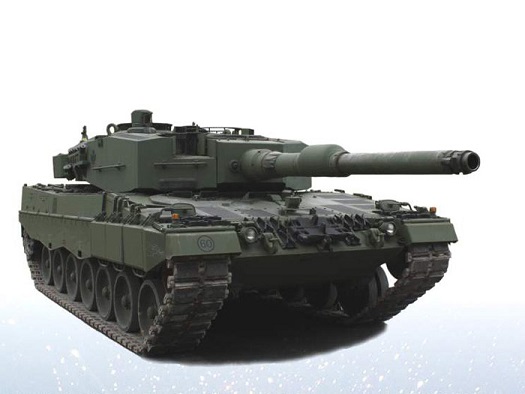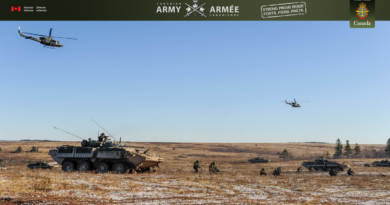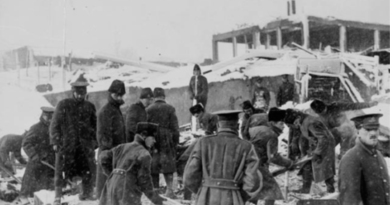Armoured Fighting Vehicles
Battle tank – (MBT, main battle tank) a self-propelled armoured fighting vehicle, capable of heavy firepower, primarily of a high muzzle velocity direct fire main gun necessary to engage armoured and other targets, with high cross-country mobility, with a high level of self-protection, and which is not designed and equipped primarily to transport combat troops. Such armoured vehicles serve as the principal weapon system of ground-force tank and other armoured formations. Battle tanks are tracked armoured fighting vehicles which weigh at least 16.5 metric tonnes unladen weight and which are armed with a 360-degree traverse gun of at least 75 millimetres calibre. In addition, any wheeled armoured fighting vehicles entering into service which meet all the other criteria stated above shall also be deemed battle tanks. (OSCE1)
Armoured combat vehicle – a self-propelled vehicle with armoured protection and cross-country capability. Armoured combat vehicles include armoured personnel carriers, armoured infantry fighting vehicles and heavy armament combat vehicles. (OSCE1)
Armoured personnel carrier (APC) – means an armoured combat vehicle which is designed and equipped to transport a combat infantry squad (six to fourteen soldiers) and which, as a rule, is armed with an integral or organic weapon of less than 20 millimetres calibre. (OSCE1)
Armoured infantry fighting vehicle (AIFV) – an armoured combat vehicle which is designed and equipped primarily to transport a combat infantry squad, which normally provides the capability for the troops to deliver fire from inside the vehicle under armoured protection, and which is armed with an integral or organic cannon of at least 20 millimetres calibre and sometimes an antitank missile launcher. Armoured infantry fighting vehicles serve as the principal weapon system of armoured infantry or mechanised infantry or motorised infantry formations and units of ground forces. (OSCE1)
Heavy armament combat vehicle – an armoured combat vehicle with an integral or organic direct fire gun of at least 75 millimetres calibre, weighing at least 6.0 metric tonnes unladen weight, which does not fall within the definitions of an armoured personnel carrier, or an armoured infantry fighting vehicle or a battle tank. (OSCE1)
Armoured car – a comparatively lightweight, wheeled armoured fighting vehicle that is usually employed in reconnaissance, armed escort, surveillance, internal security and peacekeeping duties. Its armament can consist of a single machine gun like on the Ferret Scout Car used by Canada in the 1950s and 1960s, up to a 105 mm rifled gun as found on the French AMX 10 RC. Armoured cars are generally not used as a main type of combat vehicle although the French used them in the 6 Light Armour Division as part of coalition forces during the Gulf war in 1991-2. Armoured cars are generally faster than heavy armour such as tanks and tracked infantry fighting vehicles, yet comparatively lightly armoured in comparison to a main battle tank such as the Leopard 2. Armoured cars predate tanks, as they were initially developed by the Royal Navy Air Service to rescue down pilots from the battlefield during the First World War. Major use was by the Canadian Contingent as Canada developed the first armour formations of armoured cars in 1914 with standing up of the Canadian Automobile Machine Gun Brigade Number 1 in Ottawa on 2 September 1914 under the brilliant but little known Brigadier-General Raymond Brutinel. Eventually two brigades were formed and served on the Western Front through the entire war. Canada has used armoured cars for peacekeeping missions since the Suez crisis. The modern equivalent is found in Canadian service as the current Tactical Armour Patrol Vehicle and the armoured version of the Mercedes G-Wagen in Regular and Reserve armour regiments and reconnaissance platoons of Canadian infantry battalions. (various2)
Self-propelled artillery (SPG, self-propelled gun) – often misidentified as battle tanks but have the explicit role of providing indirect fire as opposed to direct fire. Self-propelled artillery are often on the same physical scale as main tanks but often have larger main guns with longer range and are not usually employed within direct fire effect of the enemy.
Field engineering support vehicles (AEV, armoured engineering vehicle) – may be based on a vehicle chassis as large as a main battle tank or as small as an armoured personnel carrier. These vehicles typically embody equipment designed to aid in field engineer tasks and include plows, cranes, mine flails, earth moving attachments, augers and other powered equipment. Field engineering support vehicles come in both wheeled and tracked forms. Some field engineering support vehicles may even include cannons of limited size and range designed for localized explosive demolitions – these cannons are not designed or typically employed as direct or indirect weapons against enemy vehicles or personnel.
Logistic support vehicles – typically based on APC or APC-sized vehicle chassis and would include self-defence capable weapons. The roles of these vehicles include casualty evacuation ambulances, maintenance (e.g., equipment, vehicle, communities and weapons maintenance), supply transportation (fuel, ammunition, general supplies) or any other logistical support that might need to keep up with and provide first echelon support to armoured and mobile combat arms and other forces. Logistic support vehicles come in both wheeled and tracked forms.
Notes:
1. Treaty on Conventional Armed Forces in Europe




